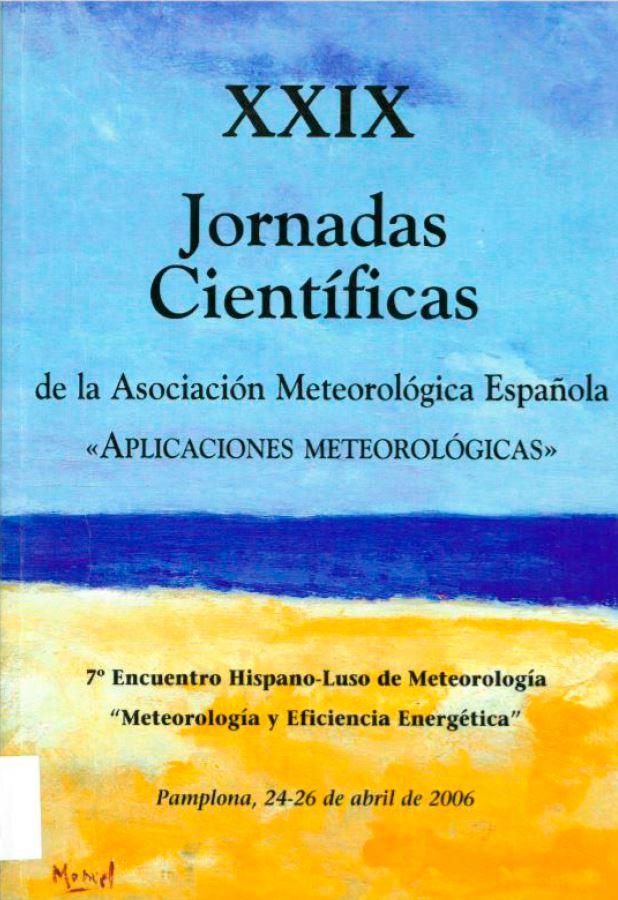MEDIDAS OPERATIVAS DERIVADAS DE UN RADIOMETRO GUV2511 MULTIRANGO
Resumen
Con el objetivo de investigar los procesos de la radiación UV-B en la atmósfera, se ha dotado a la Estación de Observación de la Atmósfera de Santiago de Compostela (EOAS) del radiómetro GUV 2511 (Biospherical Instruments, Inc.). Se trata de un instrumento singular de funcionamiento automático con mantenimiento reducido, que mide valores espectrales de irradiancia en seis longitudes de onda dentro del espectro UVBasándose en los trabajos de Stamnes et al (1991) y Dahlback (1996) y mediante la aplicación del modelo de transferencia radiativa FastRT (Engelsen et al., 2005), se ha desarrollado un procedimiento para la determinación de los valores de columna total de ozono, columna de agua líquida e Índice UV
(UVI).
El procedimiento ha sido codificado en lenguaje FORTRAN, y calcula de forma automática y en tiempo real estos parámetros para su incorporación en la base de datos de MeteoGalicia y el posterior análisis de los mismos.
Los resultados obtenidos han sido validados utilizando distintas metodologías, dependiendo del parámetro derivado. En todos los casos, las tendencias de los valores estimados mediante la metodología descrita concuerdan con las obtenidas a partir de los parámetros de contraste empleados.
Citas
Berger D. S. 1976: The sunburning ultraviolet meter: design and performance. Photochemistry and Photobiology, 24, 587-593.
Bernhard G., Booth C. R., Ehramjian J. C., 2005: Real-time ultraviolet and column ozone from multichannel UV radiometers deployed in the National Science Foundation’s ultraviolet monitoring network. Optical Engineering 44, 04101 (1-11)
Bernhard G., 2006: Spectral Response. Comunicación Personal
Biospherical Instruments Inc., 1998: GUV “Diffey Dose” Calculations. Application Note
Biospherical Instruments Inc., 1998: GUV data processing and quality control procedures.
Dahlback A., 1996: Measurements of biologically effective UV doses, total ozone abundances, and cloud effects with multichannel, moderate bandwidth filter instruments. Applied Optics 35, 6514-6521
Engelsen O., Kylling A., 2005: Fast simulation tool for ultraviolet radiation at the earth’s surface. Optical Engineering 44, 041012 (1-7)
GUV 2511 High speed ground-based Ultraviolet radiometer User’s manual. Biospherical instruments Inc., San Diego, California
Página web de Bernhard Mayer (Instituto Aeroespacial Alemán, DLR): http://www. bmayer.de/thceff.html
Página web de la facultad de Física de Oslo relacionada con la monitorización de los niveles de ozono y de UVI: http://www.fys.uio.no/plasma/ ozone/
Página web del Instituto Nacional de Meteorología, que contiene valores de ozono y UVI medidos en las principales ciudades españolas: http:// www.inm.es/web/infmet/tobsr/ulvio/estaciones html
Página web del proyecto TOMS: http://toms.gsfc. nasa.gov/
Página web official del modelo de transferencia radiativa FastRT:http://zardoz.nilu.no/~olaeng/fastrt/ fastrt.html
Hu, Y.-X., Stamnes K., 1993: An accurate parameterization of the radiative properties of water clouds suitable for use in climate models. J. Climate, 6(4), 728-742
Iqbal M., 1983: An introduction to solar radiation. Academic Press, San Diego.
Jacobson M. Z., 2002: Atmospheric Pollution. Cambridge University Press, Cambridge
Logger, Data acquisition software, software manual. Biospherical instruments Inc., San Diego, California
Long C. N., Ackerman T. P., 2000: Identification of clear skies from broadband pyranometer measurements and calculation of downwelling shortwave cloud effects. Journal of Geophysical Research, 105 (D12), 15609-15626
Mayer B., Seckmeyer G., Kylling A., 1997: Systematic long-term comparison of spectral UV measurements and UVSPEC modeling results. Journal of Geophysical Research, 102, D7, 87558767
Mayer B., Kylling A., Madronich S., Seckmeyer G., 1998: Enhanced absorption of UV radiation due to multiple scattering in clouds: experimental evidence and theoretical explanation. Journal of Geophysical Research, 103, D23, 31241-31254
Mayer B., 2005: A question on ozone retrieval method (by Stamnes, 1991). Comunicación personal
Mc Kinlay A. F., Diffey B. L., 1987: A reference action spectrum for ultraviolet induced erythema in human skin. CIE Journal, 6: 17-22
Pettazzi A., Montero P., Balseiro C., Souto J. A., Pérez Muñuzuri V., 2004. Evaluation of a radiative transfer model for UVI operational forecast in Galicia (Spain). Proceeding of European Geosciences Union 1st Assembly. Nice (France), 24-29 April 2004
Pettazzi A., Souto J. A., Salsón S., 2006: EOAS, a shared joint atmospheric observation site of MeteoGalicia. Proceedings of 4th ICEAWS - International Conference on Experiences with Automatic Weather Stations, Lisboa, Portugal.
Schmalwieser A. W., Schauberger G., Janouch M., Ebertseder T., Coetzee G. J. R., Weihs P., 2004.: Differences in the calculated erythemally effective UV radiation due to the use of total ozone values derived from different instruments. Proceedings of the 1st European Geosciences Union General Assembly, Nice, France, 25-30 April.
Solar Light, 1991: User’s manual for UV-B Biometer model 501.
Stamnes K., Slusser J., Bowen M., 1991: Derivation of total ozone abundances and cloud effects from spectral irradiance measurements. Applied Optics 30, 4418-4426
Urback F., 1989: Potential effects of altered solar
ultraviolet radiation on human skin cancer. Photochemistry and Photobiology, 50, 507-513

